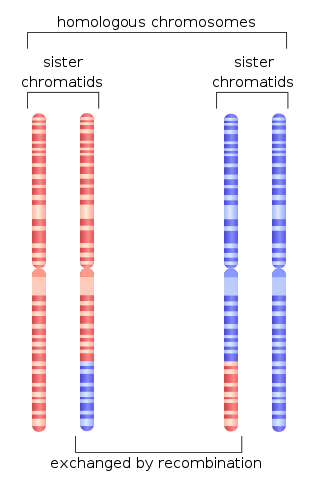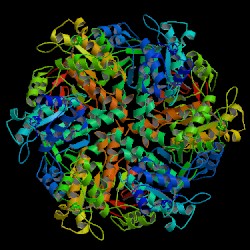Related Research Articles

p53, also known as Tumor protein P53, cellular tumor antigen p53, or transformation-related protein 53 (TRP53) is a regulatory protein that is often mutated in human cancers. The p53 proteins are crucial in vertebrates, where they prevent cancer formation. As such, p53 has been described as "the guardian of the genome" because of its role in conserving stability by preventing genome mutation. Hence TP53 is classified as a tumor suppressor gene.

DNA repair is a collection of processes by which a cell identifies and corrects damage to the DNA molecules that encodes its genome. In human cells, both normal metabolic activities and environmental factors such as radiation can cause DNA damage, resulting in tens of thousands of individual molecular lesions per cell per day. Many of these lesions cause structural damage to the DNA molecule and can alter or eliminate the cell's ability to transcribe the gene that the affected DNA encodes. Other lesions induce potentially harmful mutations in the cell's genome, which affect the survival of its daughter cells after it undergoes mitosis. As a consequence, the DNA repair process is constantly active as it responds to damage in the DNA structure. When normal repair processes fail, and when cellular apoptosis does not occur, irreparable DNA damage may occur. This can eventually lead to malignant tumors, or cancer as per the two-hit hypothesis.

ATM serine/threonine kinase or Ataxia-telangiectasia mutated, symbol ATM, is a serine/threonine protein kinase that is recruited and activated by DNA double-strand breaks, oxidative stress, topoisomerase cleavage complexes, splicing intermediates, R-loops and in some cases by single-strand DNA breaks. It phosphorylates several key proteins that initiate activation of the DNA damage checkpoint, leading to cell cycle arrest, DNA repair or apoptosis. Several of these targets, including p53, CHK2, BRCA1, NBS1 and H2AX are tumor suppressors.

Homologous recombination is a type of genetic recombination in which genetic information is exchanged between two similar or identical molecules of double-stranded or single-stranded nucleic acids.

DNA repair protein RAD51 homolog 1 is a protein encoded by the gene RAD51. The enzyme encoded by this gene is a member of the RAD51 protein family which assists in repair of DNA double strand breaks. RAD51 family members are homologous to the bacterial RecA, Archaeal RadA and yeast Rad51. The protein is highly conserved in most eukaryotes, from yeast to humans.

Serine/threonine-protein kinase ATR, also known as ataxia telangiectasia and Rad3-related protein (ATR) or FRAP-related protein 1 (FRP1), is an enzyme that, in humans, is encoded by the ATR gene. It is a large kinase of about 301.66 kDa. ATR belongs to the phosphatidylinositol 3-kinase-related kinase protein family. ATR is activated in response to single strand breaks, and works with ATM to ensure genome integrity.

Checkpoint kinase 1, commonly referred to as Chk1, is a serine/threonine-specific protein kinase that, in humans, is encoded by the CHEK1 gene. Chk1 coordinates the DNA damage response (DDR) and cell cycle checkpoint response. Activation of Chk1 results in the initiation of cell cycle checkpoints, cell cycle arrest, DNA repair and cell death to prevent damaged cells from progressing through the cell cycle.

DNA-dependent protein kinase, catalytic subunit, also known as DNA-PKcs, is an enzyme that in humans is encoded by the gene designated as PRKDC or XRCC7. DNA-PKcs belongs to the phosphatidylinositol 3-kinase-related kinase protein family. The DNA-Pkcs protein is a serine/threonine protein kinase consisting of a single polypeptide chain of 4,128 amino acids.

Poly [ADP-ribose] polymerase 1 (PARP-1) also known as NAD+ ADP-ribosyltransferase 1 or poly[ADP-ribose] synthase 1 is an enzyme that in humans is encoded by the PARP1 gene. It is the most abundant of the PARP family of enzymes, accounting for 90% of the NAD+ used by the family. PARP1 is mostly present in cell nucleus, but cytosolic fraction of this protein was also reported.

DNA excision repair protein ERCC-1 is a protein that in humans is encoded by the ERCC1 gene. Together with ERCC4, ERCC1 forms the ERCC1-XPF enzyme complex that participates in DNA repair and DNA recombination.

Partner and localizer of BRCA2, also known as PALB2 or FANCN, is a protein which in humans is encoded by the PALB2 gene.
The MRN complex is a protein complex consisting of Mre11, Rad50 and Nbs1. In eukaryotes, the MRN/X complex plays an important role in the initial processing of double-strand DNA breaks prior to repair by homologous recombination or non-homologous end joining. The MRN complex binds avidly to double-strand breaks both in vitro and in vivo and may serve to tether broken ends prior to repair by non-homologous end joining or to initiate DNA end resection prior to repair by homologous recombination. The MRN complex also participates in activating the checkpoint kinase ATM in response to DNA damage. Production of short single-strand oligonucleotides by Mre11 endonuclease activity has been implicated in ATM activation by the MRN complex.

Fanconi anemia, complementation group M, also known as FANCM is a human gene. It is an emerging target in cancer therapy, in particular cancers with specific genetic deficiencies.
Simon Joseph Boulton is a British scientist who has made important contributions to the understanding of DNA repair and the treatment of cancer resulting from DNA damage. He currently occupies the position of Senior Scientist and group leader of the DSB Repair Metabolism Laboratory at the Francis Crick Institute, London. He is also an honorary Professor at University College London.

Scott William Lowe is Chair of the Cancer Biology and Genetics Program in the Sloan Kettering Institute at Memorial Sloan Kettering Cancer Center. He is recognized for his research on the tumor suppressor gene, p53, which is mutated in nearly half of cancers.
Mutational signatures are characteristic combinations of mutation types arising from specific mutagenesis processes such as DNA replication infidelity, exogenous and endogenous genotoxin exposures, defective DNA repair pathways, and DNA enzymatic editing.
Maria Jasin is a developmental biologist at the Memorial Sloan Kettering Cancer Center. She is known for studying homologous recombination, a method in which double-strand breaks in DNA strands are repaired, and for discovering the role of BRCA1 and BRCA2 in cancers.
Telomeres, the caps on the ends of eukaryotic chromosomes, play critical roles in cellular aging and cancer. An important facet to how telomeres function in these roles is their involvement in cell cycle regulation.

A double-strand break repair model refers to the various models of pathways that cells undertake to repair double strand-breaks (DSB). DSB repair is an important cellular process, as the accumulation of unrepaired DSB could lead to chromosomal rearrangements, tumorigenesis or even cell death. In human cells, there are two main DSB repair mechanisms: Homologous recombination (HR) and non-homologous end joining (NHEJ). HR relies on undamaged template DNA as reference to repair the DSB, resulting in the restoration of the original sequence. NHEJ modifies and ligates the damaged ends regardless of homology. In terms of DSB repair pathway choice, most mammalian cells appear to favor NHEJ rather than HR. This is because the employment of HR may lead to gene deletion or amplification in cells which contains repetitive sequences. In terms of repair models in the cell cycle, HR is only possible during the S and G2 phases, while NHEJ can occur throughout whole process. These repair pathways are all regulated by the overarching DNA damage response mechanism. Besides HR and NHEJ, there are also other repair models which exists in cells. Some are categorized under HR, such as synthesis-dependent strain annealing, break-induced replication, and single-strand annealing; while others are an entirely alternate repair model, namely, the pathway microhomology-mediated end joining (MMEJ).
Scott Neal Keeney is an American molecular biologist.
References
- ↑ "Dr. Simon Powell - Radiation Oncology - New York, NY". www.castleconnolly.com. Retrieved 2018-10-09.
- 1 2 Suit, Herman D.; Loeffler, Jay S. (2011-02-04). Evolution of Radiation Oncology at Massachusetts General Hospital. Springer Science & Business Media. p. 141. ISBN 9781441967442.
- 1 2 3 "Simon Powell to Lead Department of Radiation Oncology". Barnes Jewish Hospital. Washington University School of Medicine in St. Louis. July 13, 2004. Archived from the original on September 5, 2015. Retrieved January 9, 2013
- 1 2 "Simon Powell Moving to Head Radiation Oncology at Washington University". Cancer Biology & Therapy. 3 (8): 699–707. 2004-05-07. doi: 10.4161/cbt.3.8.1108 . ISSN 1538-4047.
- 1 2 "Awards, Appointments, Announcements". J Natl Cancer Inst. 96 (16): 1203. 2004. doi: 10.1093/jnci/96.16.1203 .
- ↑ Bogdanich, Walt (Jan 14, 2013). "Radiation Bills Raise Question of Supervision". The New York Times. Retrieved Feb 25, 2010.
- ↑ "Simon Powell Named Chair of Radiation Oncology". 2015-12-31. Archived from the original on December 31, 2015. Retrieved January 10, 2013
- ↑ "Faculty | Gerstner Sloan Kettering Graduate School of Biomedical Sciences". www.sloankettering.edu. Retrieved 5 October 2018.
- ↑ "Weill Cornell Graduate School of Medical Sciences, Cornell University, Our Faculty". Archived from the original on December 22, 2012.
- ↑ "Biochemistry & Structural Biology, Cell & Developmental Biology, and Molecular Biology Overview". Weill Cornell Graduate School of Medical Sciences, Cornell University. Archived from the original on November 18, 2012.
- ↑ "Simon N. Powell | Memorial Sloan Kettering Cancer Center". www.mskcc.org. Retrieved 2018-10-06.
- ↑ "Simon N. Powell, M.D., Ph.D., Department of Radiation Oncology, Chairman". Washington University School of Medicine. Archived from the original on March 4, 2016. Retrieved Jan 14, 2013.
- ↑ Radiation Research Society News Annual Report - Radiation Research 2000 Retrieved January 11, 2013
- ↑ "Landes Bioscience, Cancer Biology & Therapy Journal, Editorial Board". Archived from the original on October 1, 2014.
- ↑ Lok, BH; Powell, SN (2012). "Molecular Pathways: Understanding the Role of Rad52 in Homologous Recombination for Therapeutic Advancement". Clinical Cancer Research. American Association for Cancer Research. 18 (23): 6400–6406. doi:10.1158/1078-0432.CCR-11-3150. PMC 3513650 . PMID 23071261. P. 7
- ↑ "56th Annual Meeting, Radiation Research Society, Oceans of Opportunity" (PDF). Synthetic Lethality and Repair Targeting: New Opportunities for Treatment. Radiation Research Society. Archived from the original (PDF) on May 15, 2012. Retrieved Jan 14, 2013.
- ↑ "Fellow Recipients - American Society for Radiation Oncology (ASTRO) - American Society for Radiation Oncology (ASTRO)". ASTRO. Retrieved 2018-10-06.
- ↑ "ESTRO - Varian Research Award". Clonal variation of DNA repair in a human glioma cell line. Institute of Cancer Research, Sutton, Surrey, UK. Archived from the original on March 30, 2012. Retrieved Jan 14, 2013.